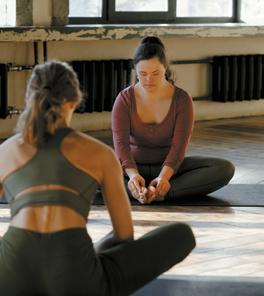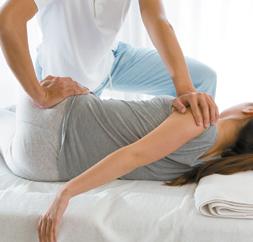
7 minute read
STRONG AND
Natural Awakenings is proudly distributed at:
Bound Brook (Bridgewater) 319 Chimney Rock Rd.
Clark 1255 Raritan Rd. Unit 150
Strong and Supple Joints How to Keep Hips and Knees Happy
Madison (Rose City) by Ronica O’Hara 222 Main St. Metuchen 645 Middlesex Ave. O ccasional knee or hip pain affects almost everyone, keeping us from daily tasks, making sitting painful tendons and ligaments include fatty fish, lentils, nuts, vegetables like spinach and broccoli, and colorful fruit like strawberand walking difficult. Causes can range ries and oranges.
Millburn-Union from over-exercise to injuries, obesity and 2245 Springfield Ave. arthritis as we age. By the time we reach Practice tai chi, qigong or hatha yoga.
Vauxhall 65 years or older, 69 percent of women The gentle, low-impact movements and
Montclair 701 Bloomfield Ave. and 56 percent of men have arthritic symptoms, according to Boston University researchers. Costly joint replacement surstretches associated with these approaches get synovial fluid flowing in the larger joints, effecting smoother mobility and
Morristown 110 Washington St. gery which carries a high risk of adverse effects is often recommended for advanced cases, but by taking simple, natural preincreased flexibility; numerous studies document that they reduce joint pain and stiffness. “The key is not just to stretch,
Newark ventive and remedial measures proactively, but to balance strength and stretching in 633 Broad St. we can strengthen our knee and hip joints, a safe, mindful way,” says Andrea Trank, handle related problems if they arise and a health coach and yoga teacher in Fort
Parsippany remain physically strong and active. Myers, Florida. Although personal or class 60 Waterview Blvd Princeton Ways to Strengthen Hips and Knees instruction is best, how-to videos can be found on YouTube. 3495 US Rt 1 S Consume foods that nourish bones and Walk every day. In a four-year Northwest
Ridgewood 44 Godwin Ave. connective tissues. For strong bones, eat foods rich in calcium, magnesium and potassium, such as dark leafy greens (bok ern University study, people at risk of knee osteoarthritis that walked at a moderate or brisk pace for at least 10 minutes a day, one
West Orange choy, Chinese cabbage, kale and collard hour a week, had one-eighth the disabled 235 Prospect Ave. greens), figs, nuts, tofu, avocados and bone mobility of those that walked less. Posbroth. Six prunes a day boosted bone denture helps: Walking straight and tall while sity in women over 70 with osteoporosis, extending each leg back as far as it’ll go will research shows. Foods that support flexible “really let your glute muscles work,” advises 30 Somerset/Middlesex/Hunterdon/Mercer/ S. Warren Co. Edition NaturalAwakeningsCNJ.com
Ways to Lower Pain Levels
Consider the right supplements. Obtaining 1,000 milligrams daily of calcium and 600 international units of vitamin D is essential for bone health, according to the National Institutes of Health; consider taking a supplement if the diet is not adequate. In addition, study-proven options that reduce joint pain in the knees and hips include glucosamine and chondroitin, S-adenosyl-L-methionine (SAMe) and avocado soybean unsaponifiable.
The benefits of bodywork. A massage can loosen up tight muscles and realign structural issues in the knees and hips while also lowering stress-producing cortisol and raising levels of pain-reducing serotonin. A study at Canada’s McMaster University found that massage works on the cellular level to reduce inflammation and promote the growth of new mitochondria in muscles. Useful styles are Swedish, deep tissue, myofascial release and shiatsu. Ask for references from friends, medical practitioners, fitness centers and natural health stores or find online a certified practitioner with at least 500 hours of training.
Try acupuncture. A new meta-study of 39 studies with 20,827 patients concluded that acupuncture effectively reduces pain for as long as 12 months, and the National Institutes of Health endorses it for knee pain. “It is believed to stimulate the nervous system and in turn, the way the brain registers pain signals,” says acupuncturist Daryl Thuroff, at the Yinova Center, in New York City. Find an acupuncturist at nccaom.org/find-a-practitioner-directory.

National Chiropractic Health Month The American Chiropractic Association has designated October as National Chiropractic Health Month to raise public awareness of the importance of musculoskeletal health and the benefits of chiropractic care and its natural, wholeperson, patient-centered and drug-free approach to health and wellness. Find a searchable directory of chiropractors at HandsDownBetter.org/find-a-doctor.
jopanuwatd/AdobeStock.com

Consult a chiropractor. People with osteoarthritic knees that underwent two weeks of chiropractic knee adjustments had substantially less pain, better mobility and fewer grinding and clicking sensations in the knees, reported a study in The Journal of the Canadian Chiropractic Association. In a small study in the Journal of Manipulative and Physiological Therapeutics, four out of five patients with hip arthritis noticed improved symptoms after nine or fewer chiropractic treatments. Many chiropractors offer not only spinal adjustments, but also a range of treatments from exercises to prolotherapy.

Explore injection therapies. Known as regenerative medicine, these therapies use injections in the knee or hip to naturally stimulate the body to produce collagen and rejuvenate tissue. In a British Medical Bulletin meta-study, 82 percent of patients with mild to moderate osteoarthritis of the knee were satisfied with prolotherapy, which uses dextrose injections. Platelet-rich plasma injections use centrifuged platelets from the patient’s body, and have been used by athletes like Tiger Woods and Rafael Nadal to treat sports injuries.
Ronica O’Hara is a Denver-based health writer. Connect at OHaraRonica@gmail.com.
Supplements for Suppleness Glucosamine and chondroitin. Research suggests this combo relieves pain, improves joint mobility and slows arthritic damage to the joints. One study found it benefits up to 70 percent of people with knee arthritis, and a large multinational trial found the mixture to be as effective at reducing pain, stiffness and swelling in knee osteoarthritis as the nonsteroidal anti-inflammatory drug (NSAID) celecoxib. It appears most suited for treating moderate to severe pain and takes two months to take effect.

SAMe. This naturally occurring S-adenosyl-L-methionine molecule builds strong joints by delivering sulfur to cartilage, and research shows it may be as effective as aspirin and ibuprofen at improving joint function. It takes a month to take effect, but doesn’t have the side effects of NSAIDs. It’s also been shown to lower depression.
Avocado soybean unsaponifiable (ASU). Routinely used to treat osteoarthritis in Europe, ASU improves symptoms of hip and knee osteoarthritis (OA) and reduces or eliminates the use of NSAIDs, a meta-analylsis concluded; it also appears to reduce OA’s progression.
lblinova/AdobeStock.com
Pain Relief with Chiropractic
In addition to the traditional chiropractic focus on adjusting the spine to ease joint pain, many doctors today are using a wide array of approaches to ameliorate hip and knee pain, whether the cause is an injury, inflammation, arthritis or another chronic condition.
Determining the cause is the first step, says chiropractor Derrell Blackburn, senior manager of chiropractic relations and training for The Joint Chiropractic, a nationwide chain of 500 clinics. If both hips or knees go bad, he says, it’s probably due to aging. If the problem involves a hip or knee on one side, “the underlying truth is overuse or compensation,” which can be helped by realigning the sacroiliac joint or pelvic girdle.
Chiropractor Gil Kentof, of the Dr. Gil Center for Back, Neck, and Chronic Pain Relief, in Franklin, Tennessee, first recommends that patients with hip pain join a basic yoga class, find a good video or search “hip stretches” online and exercise according to what they research five times a week. “If there is no improvement in three weeks, or if there is more pain while doing the exercises, an examination is in order to determine the origin of the pain and the best treatment option,” he says.
The exam often includes X-rays and sometimes an MRI. Treatment options can include specific chiropractic adjustments, deep tissue laser therapy, stem cell injections into the hip joint and in severe cases, a referral for surgery, but, “Surgery is always a last resort,” he says. For knees, “Good success has been obtained with stem cell treatment and platelet-rich plasma injected into the knee,” he advises. “This procedure is performed by our medical team and is minimally invasive with very little downtime.” He also suggests that knee-pain patients stretch their hamstrings, quadriceps and calves on a regular basis and use a pull-on brace or ice packs for temporary relief.




